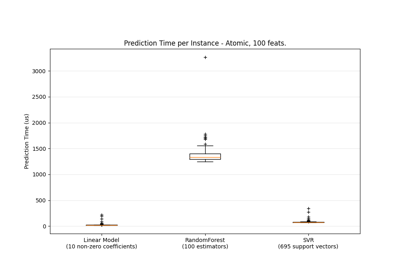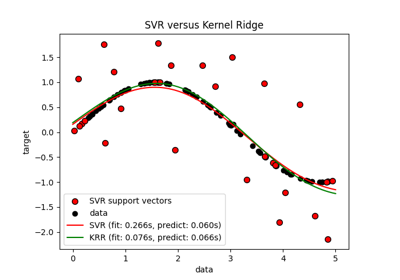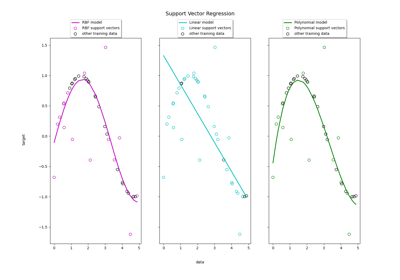SVR#
- class sklearn.svm.SVR(*, kernel='rbf', degree=3, gamma='scale', coef0=0.0, tol=0.001, C=1.0, epsilon=0.1, shrinking=True, cache_size=200, verbose=False, max_iter=-1)#
Epsilon-支持向量回归。
模型中的自由参数是C和epsilon。
该实现基于libsvm。拟合时间复杂度超过样本数量的二次方,这使得它难以扩展到超过几万个样本的数据集。对于大数据集,请考虑使用:class:
~sklearn.svm.LinearSVR或:class:~sklearn.linear_model.SGDRegressor,可能在使用:class:~sklearn.kernel_approximation.Nystroem转换器或其他:ref:kernel_approximation之后。更多信息请参阅:ref:
用户指南 <svm_regression>。- Parameters:
- kernel{‘linear’, ‘poly’, ‘rbf’, ‘sigmoid’, ‘precomputed’} or callable, default=’rbf’
指定在算法中使用的核类型。 如果没有给出,将使用’rbf’。如果给出一个可调用对象,它将用于预计算核矩阵。
- degreeint, default=3
多项式核函数的次数(‘poly’)。 必须是非负的。被所有其他核忽略。
- gamma{‘scale’, ‘auto’} or float, default=’scale’
‘rbf’、’poly’和’sigmoid’的核系数。
如果传递
gamma='scale'(默认),则使用1 / (n_features * X.var())作为gamma的值,如果’auto’,使用1 / n_features
如果是浮点数,必须是非负的。
Changed in version 0.22:
gamma的默认值从’auto’改为’scale’。- coef0float, default=0.0
核函数中的独立项。 它仅在’poly’和’sigmoid’中显著。
- tolfloat, default=1e-3
停止准则的容差。
- Cfloat, default=1.0
正则化参数。正则化的强度与C成反比。必须严格为正。 惩罚是平方l2。有关直观显示正则化参数C缩放效果的示例,请参见:ref:
sphx_glr_auto_examples_svm_plot_svm_scale_c.py。- epsilonfloat, default=0.1
epsilon-SVR模型中的epsilon。它指定在训练损失函数中,预测值在实际值的epsilon距离内时,不关联任何惩罚的epsilon-tube。必须是非负的。
- shrinkingbool, default=True
是否使用收缩启发式。 请参阅:ref:
用户指南 <shrinking_svm>。- cache_sizefloat, default=200
指定核缓存的大小(以MB为单位)。
- verbosebool, default=False
启用详细输出。请注意,此设置利用了libsvm中的每个进程运行时设置,如果启用,可能在多线程上下文中无法正常工作。
- max_iterint, default=-1
在求解器中迭代的硬限制,或-1表示无限制。
- Attributes:
coef_ndarray of shape (1, n_features)权重分配给特征当
kernel="linear"时。- dual_coef_ndarray of shape (1, n_SV)
决策函数中支持向量的系数。
- fit_status_int
如果正确拟合,则为0,否则为1(将引发警告)
- intercept_ndarray of shape (1,)
决策函数中的常数。
- n_features_in_int
在:term:
fit期间看到的特征数量。Added in version 0.24.
- feature_names_in_ndarray of shape (
n_features_in_,) 在:term:
fit期间看到的特征名称。仅当X的特征名称均为字符串时定义。Added in version 1.0.
- n_iter_int
优化例程运行以拟合模型的迭代次数。
Added in version 1.1.
n_support_ndarray of shape (1,), dtype=int32每个类别的支持向量数量。
- shape_fit_tuple of int of shape (n_dimensions_of_X,)
训练向量
X的数组维度。- support_ndarray of shape (n_SV,)
支持向量的索引。
- support_vectors_ndarray of shape (n_SV, n_features)
支持向量。
References
Examples
>>> from sklearn.svm import SVR >>> from sklearn.pipeline import make_pipeline >>> from sklearn.preprocessing import StandardScaler >>> import numpy as np >>> n_samples, n_features = 10, 5 >>> rng = np.random.RandomState(0) >>> y = rng.randn(n_samples) >>> X = rng.randn(n_samples, n_features) >>> regr = make_pipeline(StandardScaler(), SVR(C=1.0, epsilon=0.2)) >>> regr.fit(X, y) Pipeline(steps=[('standardscaler', StandardScaler()), ('svr', SVR(epsilon=0.2))])
- property coef_#
权重分配给特征当
kernel="linear"时。- Returns:
- 形状为 (n_features, n_classes) 的 ndarray
- fit(X, y, sample_weight=None)#
拟合SVM模型根据给定的训练数据。
- Parameters:
- X{array-like, sparse matrix} of shape (n_samples, n_features) 或 (n_samples, n_samples)
训练向量,其中
n_samples是样本的数量 和n_features是特征的数量。 对于 kernel=”precomputed”,X 的预期形状是 (n_samples, n_samples)。- yarray-like of shape (n_samples,)
目标值(在分类中是类标签,在回归中是实数)。
- sample_weightarray-like of shape (n_samples,), default=None
每个样本的权重。按样本重新调整 C。更高的权重 迫使分类器在这些点上投入更多注意力。
- Returns:
- selfobject
拟合的估计器。
Notes
如果 X 和 y 不是 C 顺序的且连续的 np.float64 数组,并且 X 不是 scipy.sparse.csr_matrix,X 和/或 y 可能会被复制。
如果 X 是一个密集数组,那么其他方法将不支持稀疏矩阵作为输入。
- get_metadata_routing()#
获取此对象的元数据路由。
请查看 用户指南 以了解路由机制的工作原理。
- Returns:
- routingMetadataRequest
MetadataRequest封装的 路由信息。
- get_params(deep=True)#
获取此估计器的参数。
- Parameters:
- deepbool, 默认=True
如果为True,将返回此估计器和包含的子对象(也是估计器)的参数。
- Returns:
- paramsdict
参数名称映射到它们的值。
- property n_support_#
每个类别的支持向量数量。
- predict(X)#
执行对X中样本的回归。
对于单类模型,返回+1(内点)或-1(离群点)。
- Parameters:
- X{array-like, sparse matrix},形状为 (n_samples, n_features)
对于kernel=”precomputed”,X的预期形状为 (n_samples_test, n_samples_train)。
- Returns:
- y_predndarray,形状为 (n_samples,)
预测的值。
- score(X, y, sample_weight=None)#
返回预测的决定系数。
决定系数 \(R^2\) 定义为 \((1 - rac{u}{v})\) ,其中 \(u\) 是残差平方和
((y_true - y_pred)** 2).sum(),而 \(v\) 是总平方和((y_true - y_true.mean()) ** 2).sum()。最好的可能得分是 1.0,它可能是负的(因为模型可能任意地差)。一个总是预测y的期望值的常数模型,忽略输入特征,将得到 \(R^2\) 得分为 0.0。- Parameters:
- Xarray-like of shape (n_samples, n_features)
测试样本。对于某些估计器,这可能是一个预计算的核矩阵或一个形状为
(n_samples, n_samples_fitted)的通用对象列表,其中n_samples_fitted是估计器拟合中使用的样本数量。- yarray-like of shape (n_samples,) or (n_samples, n_outputs)
X的真实值。- sample_weightarray-like of shape (n_samples,), default=None
样本权重。
- Returns:
- scorefloat
\(R^2\) 相对于
y的self.predict(X)。
Notes
在调用回归器的
score时使用的 \(R^2\) 得分从 0.23 版本开始使用multioutput='uniform_average'以保持与r2_score默认值一致。 这影响了所有多输出回归器的score方法(除了MultiOutputRegressor)。
- set_fit_request(*, sample_weight: bool | None | str = '$UNCHANGED$') SVR#
Request metadata passed to the
fitmethod.Note that this method is only relevant if
enable_metadata_routing=True(seesklearn.set_config). Please see User Guide on how the routing mechanism works.The options for each parameter are:
True: metadata is requested, and passed tofitif provided. The request is ignored if metadata is not provided.False: metadata is not requested and the meta-estimator will not pass it tofit.None: metadata is not requested, and the meta-estimator will raise an error if the user provides it.str: metadata should be passed to the meta-estimator with this given alias instead of the original name.
The default (
sklearn.utils.metadata_routing.UNCHANGED) retains the existing request. This allows you to change the request for some parameters and not others.Added in version 1.3.
Note
This method is only relevant if this estimator is used as a sub-estimator of a meta-estimator, e.g. used inside a
Pipeline. Otherwise it has no effect.- Parameters:
- sample_weightstr, True, False, or None, default=sklearn.utils.metadata_routing.UNCHANGED
Metadata routing for
sample_weightparameter infit.
- Returns:
- selfobject
The updated object.
- set_params(**params)#
设置此估计器的参数。
该方法适用于简单估计器以及嵌套对象(例如
Pipeline)。后者具有形式为<component>__<parameter>的参数,以便可以更新嵌套对象的每个组件。- Parameters:
- **paramsdict
估计器参数。
- Returns:
- selfestimator instance
估计器实例。
- set_score_request(*, sample_weight: bool | None | str = '$UNCHANGED$') SVR#
Request metadata passed to the
scoremethod.Note that this method is only relevant if
enable_metadata_routing=True(seesklearn.set_config). Please see User Guide on how the routing mechanism works.The options for each parameter are:
True: metadata is requested, and passed toscoreif provided. The request is ignored if metadata is not provided.False: metadata is not requested and the meta-estimator will not pass it toscore.None: metadata is not requested, and the meta-estimator will raise an error if the user provides it.str: metadata should be passed to the meta-estimator with this given alias instead of the original name.
The default (
sklearn.utils.metadata_routing.UNCHANGED) retains the existing request. This allows you to change the request for some parameters and not others.Added in version 1.3.
Note
This method is only relevant if this estimator is used as a sub-estimator of a meta-estimator, e.g. used inside a
Pipeline. Otherwise it has no effect.- Parameters:
- sample_weightstr, True, False, or None, default=sklearn.utils.metadata_routing.UNCHANGED
Metadata routing for
sample_weightparameter inscore.
- Returns:
- selfobject
The updated object.




